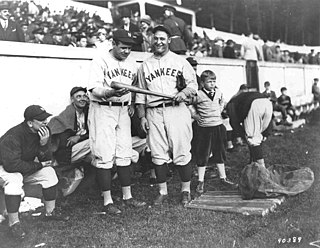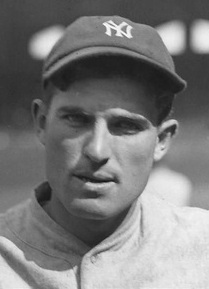Related Research Articles

Murderers' Row were the baseball teams of the New York Yankees in the late 1920s, widely considered some of the best teams in history. The nickname is in particular describing the first six hitters in the 1927 team lineup: Earle Combs, Mark Koenig, Babe Ruth, Lou Gehrig, Bob Meusel, and Tony Lazzeri.
The 1964 World Series was the championship series of Major League Baseball's (MLB) 1964 season. The 61st edition of the World Series, it was a best-of-seven playoff that matched the National League champion St. Louis Cardinals against the American League champion New York Yankees; the Cardinals prevailed in seven games. St. Louis won their seventh world championship, while the Yankees, who had appeared in 14 of 16 World Series since 1949, did not play in the Series again until 1976.
The 1938 World Series was the championship series in Major League Baseball for the 1938 season. The 35th edition of the World Series, it matched the two-time defending champion New York Yankees against the Chicago Cubs. The Yankees swept the Series in four games for their seventh championship overall and record third straight.
The 1942 World Series featured the defending champion New York Yankees against the St. Louis Cardinals, with the Cardinals winning the Series in five games for their first championship since 1934 and their fourth overall.

The 1921 World Series was the championship series in Major League Baseball for the 1921 season. The 18th edition of the World Series, it matched the National League champion New York Giants and the American League champion New York Yankees.

The 1922 World Series was the championship series in Major League Baseball for the 1922 season. The 19th edition of the World Series, it matched the National League champion New York Giants against the American League champion New York Yankees. The Giants beat the Yankees in five games in the first Series with a permanent best-of-seven format. By now, the term "World Series" was being used frequently, as opposed to "World's Series". As with the 1921 World Series, every game was played at the Polo Grounds because it housed both teams, with the home team alternating; it was also the Yankees' final series to be played at the Polo Grounds as a home team, as they would move into the then-under construction Yankee Stadium for the following season, which ended in them winning the rematch against the Giants.

The 1923 World Series was the championship series in Major League Baseball for the 1923 season. The 20th edition of the World Series, it matched the American League champion New York Yankees against the National League champion New York Giants. The Yankees beat the Giants in six games. This would be the first of the Yankees' 27 World Series championships. The series was not played in a 2–3–2 format: as with the previous two Series the home field alternated each game, though this time it involved switching ballparks, as the first Yankee Stadium had opened this season.

The 1926 World Series was the championship series of the 1926 Major League Baseball season. The 23rd edition of the Series, it pitted the National League champion St. Louis Cardinals against the American League champion New York Yankees. The Cardinals defeated the Yankees four games to three in the best-of-seven series, which took place from October 2 to 10, 1926, at Yankee Stadium and Sportsman's Park.

The 1927 World Series was the championship series in Major League Baseball for the 1927 season. The 24th edition of the World Series, it matched the American League champion New York Yankees against the National League champion Pittsburgh Pirates. The Yankees won in four games. This was the first sweep of a National League team by an American League team.
The 1932 World Series was the championship series in Major League Baseball for the 1932 season. The 29th edition of the World Series, it matched the American League champion New York Yankees versus the National League champions Chicago Cubs. The Yankees won in a four-game sweep. By far it is mostly noteworthy for Babe Ruth's "called shot" home run, in his 10th and last World Series. It was punctuated by fiery arguments between the two teams, heating up the atmosphere before the World Series even began. A record 13 future Hall of Famers played in this World Series, with three other future Hall of Famers also participating: umpire Bill Klem, Yankees manager Joe McCarthy, and Cubs manager Rogers Hornsby. It was also the first World Series in which both teams wore uniforms with numbers on the backs of the shirts.

The 1936 World Series was the championship series in Major League Baseball for the 1936 season. The 33rd edition of the World Series, it matched the New York Yankees against the New York Giants, with the Yankees winning in six games to earn their fifth championship.
The 1937 World Series featured the defending champion New York Yankees and the New York Giants in a rematch of the 1936 Series. The Yankees won in five games, for their second championship in a row and their sixth in 15 years.

Robert William Meusel was an American baseball left and right fielder who played in Major League Baseball (MLB) for eleven seasons from 1920 through 1930, all but the last for the New York Yankees. He was best known as a member of the Yankees' championship teams of the 1920s, nicknamed the "Murderers' Row", during which time the team won its first six American League (AL) pennants and first three World Series titles.
The following are the baseball events of the year 1939 throughout the world.
The following are the baseball events of the year 1927 throughout the world.

George William Pipgras was an American right-handed starting pitcher and umpire in Major League Baseball.

Benjamin Edwin Paschal was an American baseball outfielder who played eight seasons in Major League Baseball from 1915 to 1929, mostly for the New York Yankees. After two "cup of coffee" stints with the Cleveland Indians in 1915 and the Boston Red Sox in 1920, Paschal spent most of his career as the fourth outfielder and right-handed pinch hitter of the Yankees' Murderers' Row championship teams of the late 1920s. Paschal is best known for hitting .360 in the 1925 season while standing in for Babe Ruth, who missed the first 40 games with a stomach ailment.

Mark Anthony Koenig was an American baseball shortstop who played twelve seasons in Major League Baseball (MLB). He played with the New York Yankees, Detroit Tigers, Chicago Cubs, Cincinnati Reds and New York Giants from 1925 to 1936. A switch hitter who threw right-handed, he was listed at 6 feet 0 inches (1.83 m) and 180 pounds (82 kg). Although primarily playing as a shortstop, Koenig was utilized at both second base and third base as well.

Hubert Shelby "Hub" "Shucks" Pruett, was a professional baseball left-handed pitcher in Major League Baseball from 1922 to 1932. He acquired the nickname "Shucks" because that was the strongest word in his vocabulary.
References
- ↑ Montville, Leigh (2006). The Big Bam. New York: Doubleday. p. 275.
- ↑ "1928 World Series Game 1 – St. Louis Cardinals vs. New York Yankees". Retrosheet. Retrieved September 13, 2009.
- ↑ "1928 World Series Game 2 – St. Louis Cardinals vs. New York Yankees". Retrosheet. Retrieved September 13, 2009.
- ↑ "1928 World Series Game 3 – New York Yankees vs. St. Louis Cardinals". Retrosheet. Retrieved September 13, 2009.
- ↑ "1928 World Series Game 4 – New York Yankees vs. St. Louis Cardinals". Retrosheet. Retrieved September 13, 2009.
- 1 2 "October 7, 1928: Lou Gehrig's two homers too much for Redbirds in Game 3 | Society for American Baseball Research". sabr.org. Retrieved May 19, 2020.
- 1 2 Creamer, Robert (1974). Babe: The Legend Comes to Life. Simon & Schuster. ISBN 0-671-21770-4.
- ↑ Koppet, Leonard (1998). Koppet's Concise History of Major League Baseball. Philadelphia: Temple University Press. p. 170. ISBN 1-56639-638-7.
